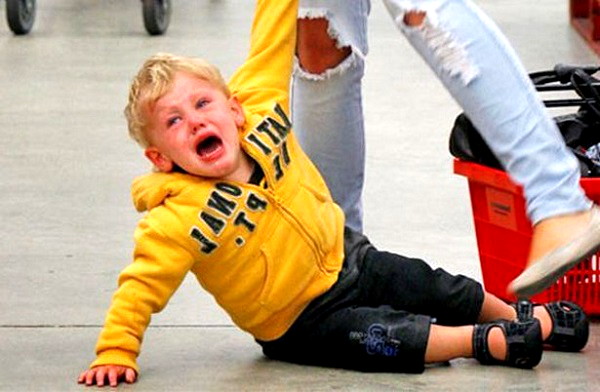You made a very wrong turn at the grocery store, and are now headed straight towards the cookie aisle.
Your toddler’s already half-way to cranky and the sight of colorful cookies covered in chocolate and icing pushes her over the edge.
You brace yourself as she whales, “Cookie now!” Her back arches, her fists flail and suddenly she’s in full-on tantrum mode.
A 2-year-old’s temper tantrum can be frustrating – for both of you. Your tot can’t control her emotions, you’re stressed and people are beginning to stare.
What can you do when your toddler has a major meltdown in a public space?
Take a Breath
The more your toddler screams, the more you want to scream back. While she doesn’t have the words right now to adequately express her feelings of frustration, you do. It’s easy to forget that you’re the adult when faced with an all too tense situation. Before reacting, stop and do some mental prep work. Close your eyes, take a deep breath and count to 10. This gives you a moment to get calm, gain composure and plan for the next step. Sure, your public mini meditation session might look silly – but, people are already looking at the wild child who’s screaming up a storm anyway.
Be Brief
Don’t start a discussion. By the time your child is in mid-tantrum it’s too late to reason with her rationally in a public place. She’s boiled over and isn’t likely to suddenly snap shut long enough to hear your 10 minute lecture on why we need to use our ‘inside voice’ and take control of our emotions. This isn’t to say that you should never discuss your child’s behavior with her – it’s just that now isn’t the right time to do it. If she’s throwing a fit because she wants something that you won’t give her (such as a cookie), look her in the eyes and say a firm, “No.” If she’s having another type of tantrum or you’re not sure of the cause, a simple, “You need to stop now” will suffice. That said, there’s a real chance that she won’t respond to your verbal cues. What now?
Make a Hasty Exit
Remove your child from the situation – pronto. Don’t wait around hoping that she’ll do an about face. If you feel like leaving the public place isn’t an option, try a brief little break. For example, you’re half-way through grocery shopping. You’ve just spent half an hour filling your cart and aren’t done yet. Your toddler is in meltdown mode, but you really don’t have time to leave the cart, go home, wait for a babysitter and go back to the store later. Ask if you can stash your cart at the customer service desk (there’s likely to be an understanding employee who has children of their own working at the store) and go outside. Take a quick walk around the outside of the store and go back in when your toddler has calmed down.
Skip the Time Out
The grocery store, mall, public pool, community playground and your favorite local restaurant aren’t places to put your child on time out. In order to make a time out effective you need a quiet place that is distraction free. Most public places have too many people and too much going on to pick a time out spot that’s suitable. Keep in mind, the goal of the time out is literally to provide ‘time out’ from an overstimulating situation. Waiting until you get home to put your tot on time out changes the technique from a way to cool down and recoup to a punishment. Avoid doing this. While as a general method, time outs can be effective – they aren’t a perfect match for public temper tantrums.
Above all remember – you aren’t the first (or the last) parent whose child has had a very public tantrum. Yes, you’ll get looks, stares and even those completely judgy head shakes. Don’t let a stranger’s opinion add extra stress to an already challenging situation. Forget about the random looks and remember that it’s normal for toddlers to have tantrums. Your child hasn’t developed the ability to completely control herself and she’s not yet a master of her emotions (or her words). The public temper tantrum doesn’t reflect on your parenting. Focus on your child and what you need to do to help her through this stage. It won’t last forever.
Further reading:
Why Tantrums Aren’t a Bad Thing (and How Parents Around the Globe Cope)

